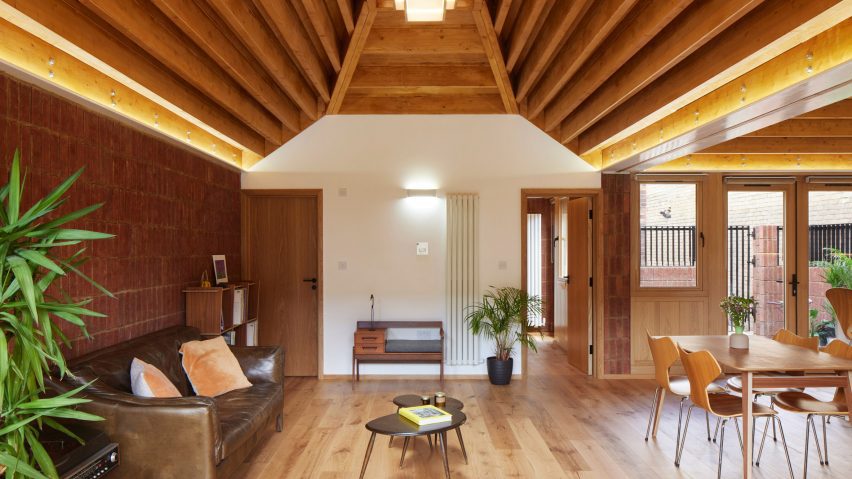London studio Satish Jassal Architects has created a two-bedroom bungalow from handmade-bricks behind shops and restaurants on Turnpike Lane in Haringey, England.
Named Haringey Brick Bungalow, the 66-square-metre home is accessed through a one-metre-wide passageway hidden between the high street's commercial premises.
The 110-square-metre site and narrow passageway was "like building through a straw", dictating many design and construction decisions.
"This was a very tricky backland site, but the key message is that with careful planning, you can succeed," said Satish Jassal Architects founder Satish Jassal.
In order to maximise the potential of the small site footprint, the architect staggered two rectangular volumes to create two courtyards – at the entrance and rear of the dwelling.
Two green roofs top the building, characterised by their asymmetrical pyramid shapes topped with rooflights.
The home was made with red, handmade bricks that maintain their "rough and imperfect texture" to create a "lived-in" feeling to integrate the building into the environment.
The bricks were stacked vertically at the base of the home and horizontally near the roof to create variation in the facade.
"This house is part of a family of brick houses that we have been developing over the last 10 years, often on tricky sites such as this one," said Jassal.
"All our homes share a common materiality and architectural language and are informed by an understanding of their particular place and the requirements of their residents."
Oak-framed windows, white stone sills and black steel elements – such as the entrance gate, courtyard fencing and brise-soleils that deflect harsh sunlight over doors and windows – complete the bungalow's material palette.
"The dark metalwork, red brick, yellow oak, and white stonework complement each other and transition from dark to light and smooth to textured," said Jassal.
"The materials have been selected to complement each other and to weather gracefully together over time."
The interior of the bungalow consists of a similar range of materials with exposed brick walls, oak flooring and glulam beams.
"The tones and textures of materials are expressed both externally and internally, bringing in the warmth of the natural external materials internally and humanising the spaces," said Jassal.
Two bedrooms are located diagonally across the home from one another, connected by a central living, dining and kitchen space – this open plan allows access into the courtyards from all spaces within the home.
"The two accommodation wings of the house were rotated and overlook the courtyards," said Jassal. The living spaces span both wings and look out to both courtyards, bringing in a different quality of light throughout the day."
"The two courtyards provide aspect and light from multiple directions making the house feel more open and spacious than the floor area suggests," he continued.
The structure of the extruded roof is supported by a steel frame, designed to track sun rays to illuminate the central space during the day.
Glulam beams were spaced evenly down the coffered ceiling, reminiscent of a chandelier – this aims to emphasise the three-and-a-half-metre height at the centre of the ceiling.
"The peaks of the two asymmetrical roofs hover over the living spaces, and the joists step up to two central roof lights, making the house feel voluminous," said Jassal.
Due to the narrow access of the site, materials were chosen for their modularity and ability to construct without large machinery.
For example, steel screw piles were used to eliminate the need for a large piling rig – individual brick modules were used to calculate the house's dimensions.
Other bungalows recently featured on Dezeen include bungalows built with bio-bricks crafted from local soil and a bungalow extension that was built with materials recovered from demolition.
The photography is by Richard Chivers.
Project credits:
Architect: Satish Jassal Architects
Client: Shazad Ashiq
Structural engineer: Corbett Tasker
Project manager: Satish Jassal Architects
Interior designer: Satish Jassal Architects
Approved building inspector: London Building Control
Main contractor: PK Construction London
Groundworks contractor: All Ground Solutions
Energy Consultant: Atspace
Arboricultural: Arboricultural Solutions

